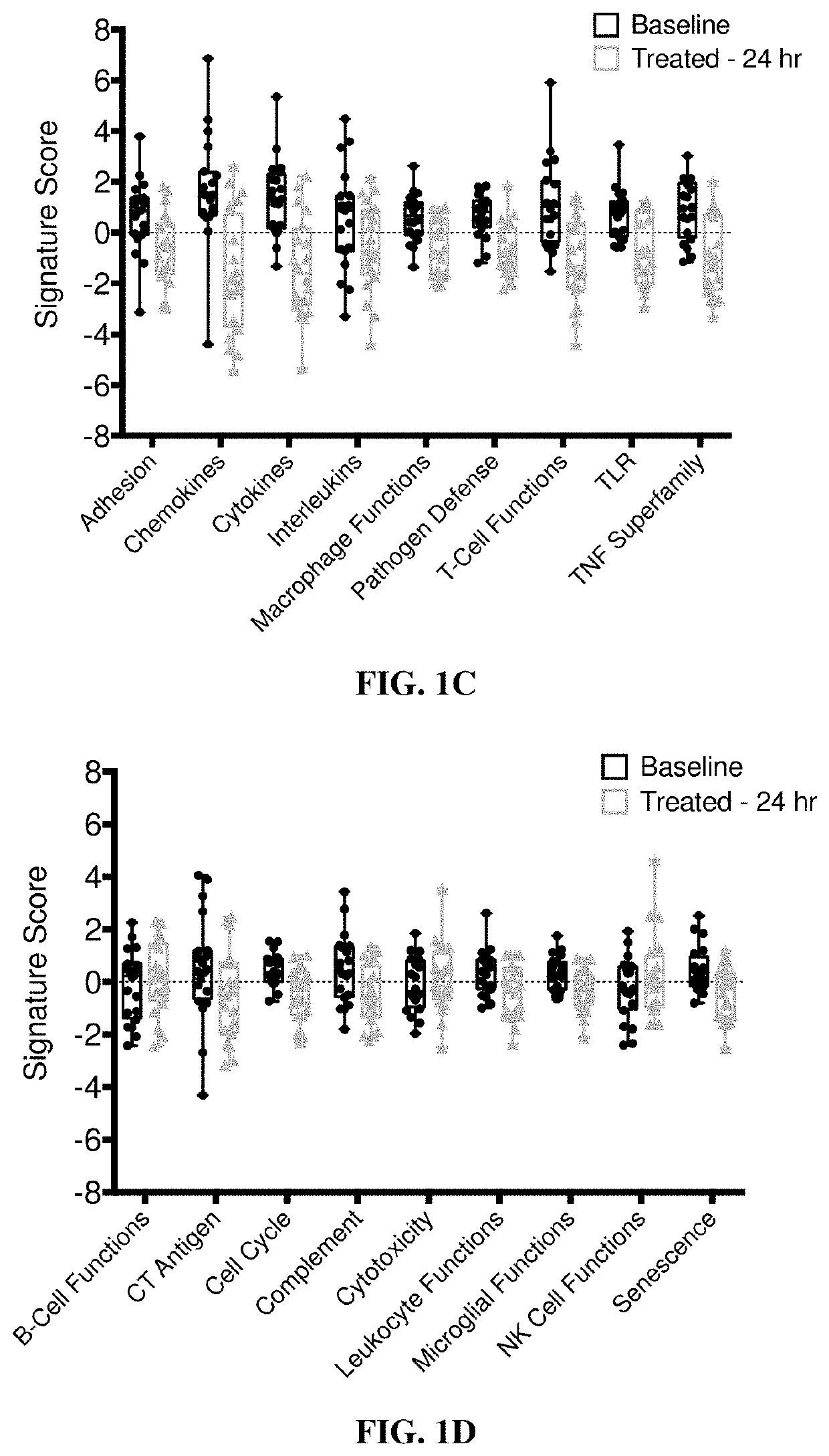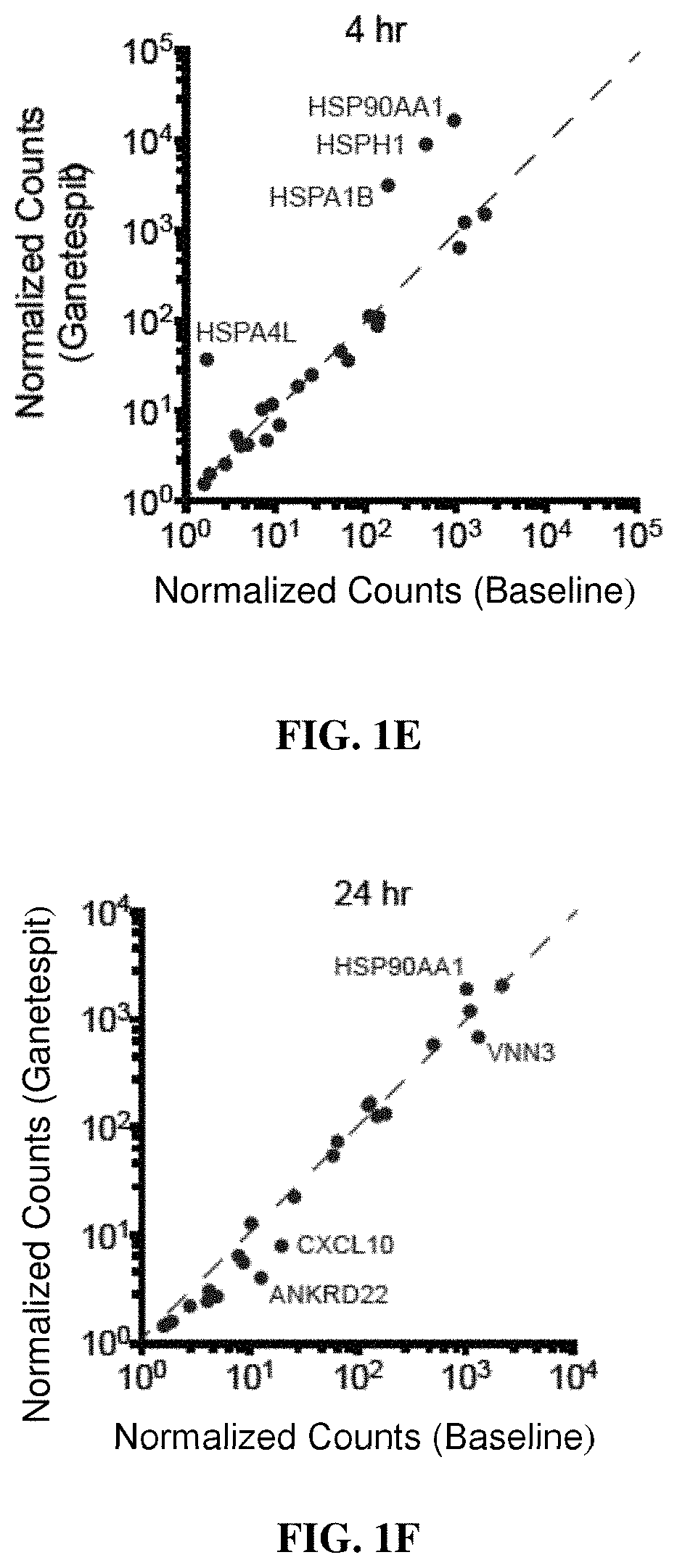Combination treatments of hsp90 inhibitors for enhancing tumor immunogenicity and methods of use thereof
a technology of hsp90 inhibitors and tumors, applied in the field of cancer treatment, can solve the problems of preventing any hsp90 inhibitor from advancing, systemic toxicity is markedly increased, and the clinical testing of an array of highly optimized hsp90 inhibitor chemotypes, either alone or in combination with other agents, is largely disappointing, and achieves the effect of enhancing the efficacy of anti-cancer therapy with hsp90 inhibitors
- Summary
- Abstract
- Description
- Claims
- Application Information
AI Technical Summary
Benefits of technology
Problems solved by technology
Method used
Image
Examples
example 1
Down-Regulate Expression of Diverse Immune-Related Genes in Cancer Patient at Clinically Recommended Doses
Methods
[0211]Clinical Sample Collection
[0212]Blood samples for gene expression analyses were obtained with informed consent from patients participating in an IRB-approved clinical trial coordinated by the Dana-Farber Cancer Institute, Boston, Mass. (DFCI 11-477, NCT01560416). All samples were processed and analyzed by collaborating investigators in an anonymous fashion to preserve patient confidentiality.
[0213]Nanostring Analysis
[0214]Gene expression measurements using Nanostring codesets were performed with NanoString XT GEx kits. Analyses were performed on total RNA from clinical samples or mouse tumor tissue following manufacturer's instructions. Briefly, 100 ng total RNA (measured by Qubit (Invitrogen)), was mixed with Capture and Reporter probe sets and hybridized for 16-20 hours at 65° C. prior to ramping down to hold at 4° C. Hybridized samples were processed on a Nanostr...
example 2
b is Immunosuppressive in Ex Vivo Human Peripheral Blood Mononuclear Cells
Methods
[0220]PBMC Isolation and RNA Sequencing
[0221]Whole blood was collected into lithium-heparin tubes and processed with Histopaque-1077 (Sigma) to isolate peripheral blood mononuclear cells per supplier's instructions. After overnight culture in RPMI160 with 20% autologous plasma, ganetespib (500 nM) or an equal volume of solvent vehicle (DMSO 0.1% v / v) was added to duplicate dishes. Incubation was continued for 24 hours after which cells were collected by centrifugation, lysed in RLT buffer (Qiagen) and total RNA isolated using an RNeasy kit per manufacturer's instructions (Qiagen). Sequencing library preparation was performed by the Whitehead Genome Technology Core using standard Illumina protocols and TruSeq adapters. Single-end, 40 bp sequencing was performed on a HiSeq 2000 instrument. Adapter sequences were trimmed, and reads were aligned to mm10 using TopHat2 and rpkm values generated with Cufflinks...
example 3
r Response of Low Dose HSP90 Inhibition in Immunocompetent and Immunosuppressed Mice
Methods
[0225]Mice
[0226]All experiments involving mice were performed under a protocol approved by the MIT Institutional Animal Care and Use Committee. MC38 cells growing in log phase were harvested by incubation with trypsin, washed 3× in PBS, and implanted (1×105 cells / site) into the right inguinal region of 6-8 week old female C57B16 mice (Jackson Labs). Once palpable, tumors were monitored every other day via digital caliper measurements and volume calculated using the following formula: Length (mm)×Width (mm)×Width (mm)×520=tumor volume in mm3. Mice were euthanized by CO2 inhalation, tumors were harvested and cut into thirds with a razor for histology, flow cytometry, and flash freezing in liquid N2 for RNA / protein isolation.
[0227]For oral dosing with HSP90i, the average water consumption of the mice was calculated by measuring water bottle weight before and after 72 hours of housing to determine...
PUM
| Property | Measurement | Unit |
|---|---|---|
| volume | aaaaa | aaaaa |
| weight | aaaaa | aaaaa |
| weight | aaaaa | aaaaa |
Abstract
Description
Claims
Application Information
 Login to View More
Login to View More - R&D
- Intellectual Property
- Life Sciences
- Materials
- Tech Scout
- Unparalleled Data Quality
- Higher Quality Content
- 60% Fewer Hallucinations
Browse by: Latest US Patents, China's latest patents, Technical Efficacy Thesaurus, Application Domain, Technology Topic, Popular Technical Reports.
© 2025 PatSnap. All rights reserved.Legal|Privacy policy|Modern Slavery Act Transparency Statement|Sitemap|About US| Contact US: help@patsnap.com



